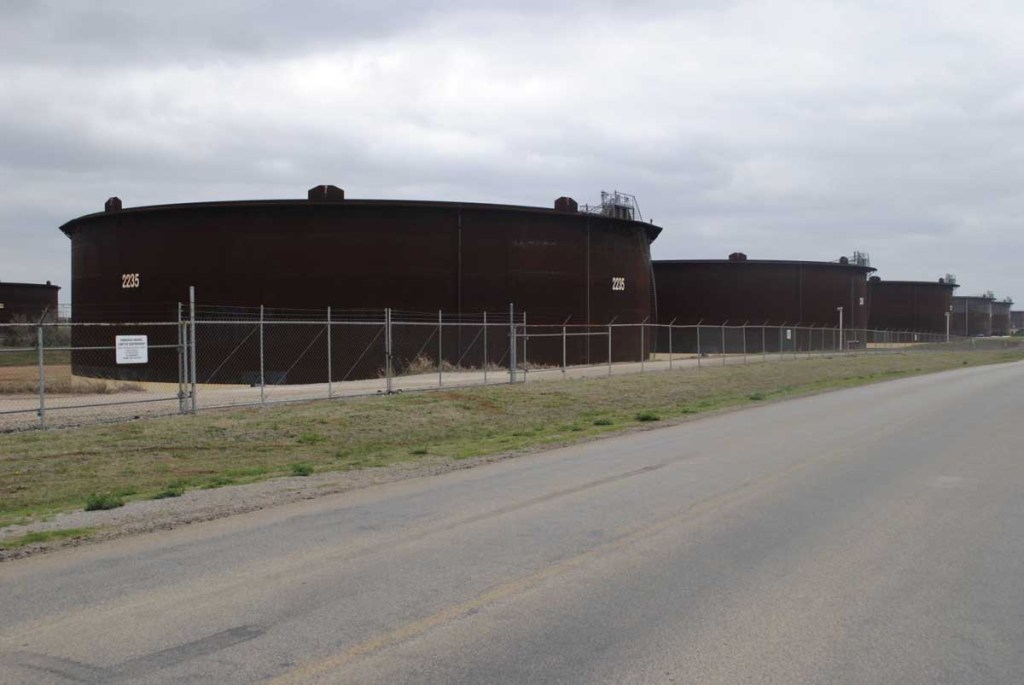Oil prices rise as supply dwindles; Oklahoma politicians call for increased domestic production
Published 4:00 pm Saturday, March 5, 2022

- Oil storage tanks in Cushing.
STILLWATER, Oklahoma – A crude oil hub in the Midwest has reported a drop in storage consistent with events around the country, as global financial markets continue reeling in the wake of Russia’s invasion of Ukraine.
Oil prices in recent days have climbed to more than $100 a barrel, and rising fuel prices are causing concern among Americans, who are already feeling the strain of inflation. The effect is acute in Oklahoma, where supplies of crude oil held in reserve at the Cushing oil storage hub – an interchange referred to as the “Pipeline Crossroads of the World” – have dropped. Tank farms south of Cushing can hold 76.6 million barrels but were down 42% in September, holding just 32.9 million – excluding pipeline fill and stocks in transit – according to the U.S. Energy Information Administration.
Oklahoma Energy Today reported Monday, Feb. 28, that the amount of storage in Cushing has continued falling, dropping to 23.8 million barrels. At the same time, the price of West Texas Intermediate crude – which is set at Cushing – had increased 8% to more than $103 per barrel in trading on the New York Mercantile Exchange. That was the highest close since July 2014 and the largest daily percentage gain since November 2020, according to the energy industry newsletter.
The industry also reported members of the International Energy Agency, including the U.S. and Japan, have agreed to release 60 million barrels of reserves to alleviate supply concerns. During his State of the Union Address, President Joe Biden said 30 million of those barrels would come from the U.S. reserve.
Oklahoma Gov. Kevin Stitt on Tuesday, March 1, said he sent a letter to Biden, urging the president to push for more domestic oil production. Members of Oklahoma’s congressional delegation also issued statements calling on Biden to reduce regulations and ramp up domestic oil production.In his letter, Stitt called Russia’s actions “deeply troubling” and urged Biden to embrace America’s domestic crude oil and natural gas industry, prioritizing energy independence.
“The recent events in Ukraine are yet another example of why we should be selling energy to our friends and not buying it from our enemies,” he wrote. “Energy-producing states like Oklahoma are ready to step up domestic production in an environmentally responsible way. My state is the nation’s fourth-largest producer of natural gas the sixth-largest in oil production. … With your support, we can significantly increase production to meet America’s domestic needs and export energy to our allies, reducing their dependance on foreign adversaries.”
Stitt requested that the Biden administration halt the import of Russian crude oil and natural gas products; work with American oil and gas producers to increase domestic output; and encourage construction of crude oil and natural gas infrastructure, including pipelines.
According to the U.S. Energy Information Administration, the U.S. produces about 11-12 million barrels of crude oil per day. In 2020 it consumed a little more than 18 million barrels per day, a drop in consumption but still more than domestic production. It imported a total of 6,422,000 barrels of crude oil from Persian Gulf, OPEC and Non-OPEC countries in December, EIA reports show. The vast majority of the oil imported by the U.S. comes from Canada and Mexico.
Russia began providing a larger portion than it had previously when the U.S. stopped importing oil from Venezuela in 2019 after the Trump administration imposed sanctions. Venezuela was once one of the largest providers of oil to the U.S.
In spite of the increased importation of Russian oil – up by 28% in the first 11 months of 2021, according to PolitiFact, a fact-checking program provided by the Poynter Institute for Media Studies – Russia accounted for about 3 percent of overall crude oil imported to the U.S. in 2021.
Oil rigs in the U.S. were shut down in 2020 and 2021 as oil prices tanked when global demand dropped during the COVID-19 pandemic. But domestic production is increasing and rig counts are on the rise, gradually climbing over the course of 2021, according to EIA reports.
Oklahoma’s rig count – at a recent high of 116 in March 2019 – was 52 on Feb. 25, but that number was sharply up from 17 on the same date a year ago. The lowest recent count was nine active rigs in July 2020.





